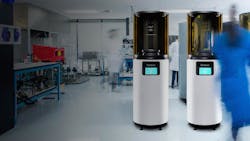3-D Printing's Next Frontier? A New Process Takes Shape with the Help of BMW, Delphi, Ford
Terminator II fans may well remember T-1000, the villain made of metallic goo who rose from a puddle to assume the form of a weapon or the 3-D likeness of a terminated victim.
The physicist and two chemists who founded a Silicon Valley company called Carbon credit the shape-shifting character with their idea for a faster 3-D printer. Instead of building up an object layer by layer, like a traditional 3-D printer, the printer pulls a pattern out of a puddle of resin. (Video) Through a proprietary technology called CLIP—continuous liquid interface production--light on the ultraviolet spectrum turns the resin into solid and oxygen leaves voids in the object.
The company says the printer, called the M1, is capable of printing 25 to 100 times faster than a traditional 3-D printer, depending on the dimensions of the object and the resin used. The M1 specializes in isotrophic parts—parts with identical dimensions on all sides—in a range of plastics. It can speed up the prototyping process, and handle more organic, flowing shapes than a traditional 3-D printer.
The technology, launched last year, has raised the interest—and the venture capital funds—of automakers including Ford, Delphi and BMW, which are separately collaborating with Carbon to develop applications for the technology. M1 also has medical applications, among them building customized stents on-demand in emergency situations.
Sasha Seletsky, Carbon’s director of applications, migrated to the 170-person outfit from Tesla last year, where he was a senior manager of research and development. A materials engineer with a dual degree in finance, he “wanted a smaller company that was on top of transforming an industry that made a physical product and had some cool science or technology behind it.” Carbon’s vice presidents of engineering and manufacturing and its director of software are also Tesla transplants.
Seletsky is putting his materials science background to good use, as the company develops and manufactures its own resins for printing applications. Right now, Carbon is working on making rigid polyurthethane more appropriate for automotive applications, improving thermal and impact-strength properties. Carbon also develops its own CLIP software, “so as we develop new materials, we can push [out] new software that allows the printer to print these new materials,” says Seletsky.
Delphi uses the technology for prototypes of production parts where the materials and surface finishes require a higher grade than traditional 3-D printing offers, said Jerry Rhinehart, Delphi manager of additive manufacturing, in an email. Eliminating the layering aspect of 3D printing allows for smoother surfaces.
“Ultimately, the goal is printing parts for production applications,” said Rhinehart. “Imagine having complete design freedom without the limitations of injection molding or the cost of the tooling.”
A Forbes article in September said that BMW was installing Carbon printers on the production floor; however, Seletsky says the technology is primarily used for prototyping and validation at this point. Companies can lease the printers for around $40,000 a year—there is currently no purchase option.
“There are a few small-volume cases where it’s used as the production solution,” he says. “In other cases we are involved in programs to consolidate the materials and the parts for use as the production solution in higher volumes. We’re still in the development phases, but we’ve identified specific applications.”
The printer’s maximum build area is roughly 3 inches by 5 ½ inches by 13 inches. Seletsky says the M1 works best for small, complex parts with mechanical properties where surface finish must be smooth to operate properly—such as connectors, switches or parts involved in fluid flow. Anything where “the tooling cost is very expensive because they’re very complex, but the size of the parts is not very large, so printing them is quite feasible,” he says.
Another forte is printing complex mesh structures. “For example, in the floor of a cabin, they have to design a duct to go underneath the seat,” says Seletsky. “You need to manufacture the duct, and then you need some structure in the floor so when you step, you don’t crush the duct. And those are usually two separate parts—you have the foam spacer and you have the duct separately. But with our technology, you could print some kind of mesh structure with the duct running through it, so that’s integrated as one part.
No word yet on whether the M1’s CLIP technology is a game-changer like injection molding was in the 1950s and ‘60s, but Seleskty says he’s already seeing the M1 speed up the automotive design and validation process.
“We’ve worked with engineers who otherwise might have been stuck going through five, six iterations on a tool that would take several months,” he says. “Instead we’re able to iterate on a daily basis, and they’re able to lock in on the design that works within the span of a week rather than a span of months.”
About the Author

Laura Putre
Senior Editor, IndustryWeek
As senior editor, Laura Putre works with IndustryWeek's editorial contributors and reports on leadership and the automotive industry as they relate to manufacturing. She joined IndustryWeek in 2015 as a staff writer covering workforce issues.
Prior to IndustryWeek, Laura reported on the healthcare industry and covered local news. She was the editor of the Chicago Journal and a staff writer for Cleveland Scene. Her national bylines include The Guardian, Slate, Pacific-Standard and The Root.
Laura was a National Press Foundation fellow in 2022.
Got a story idea? Reach out to Laura at [email protected]
